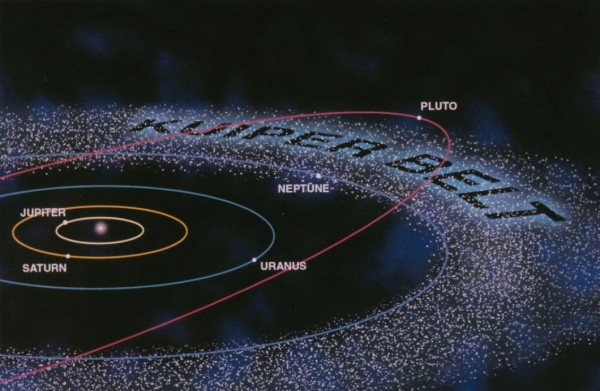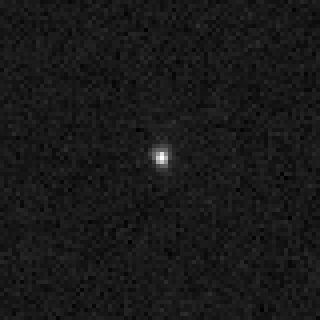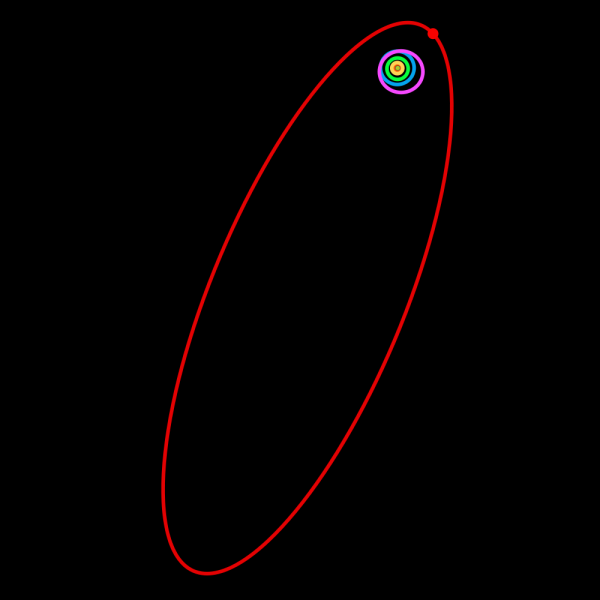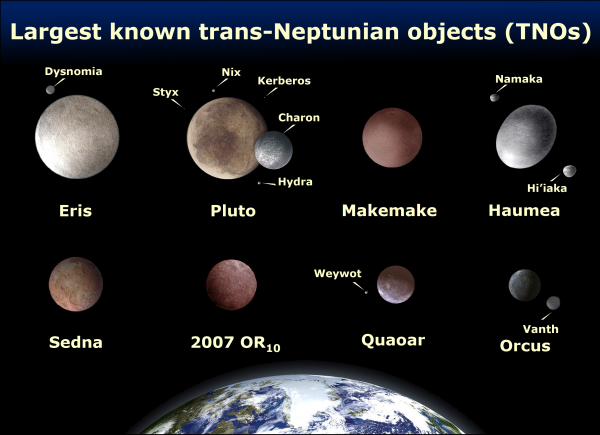"The great oak of Astronomy has been felled, and we are lost without its shadow." -Subrahmanyan Chandrasekhar, on the passing of Jan Oort
In our new semi-regular series, readers from all over the world (and in low-Earth orbit, too, because why not!) are invited to send in their questions and suggestions for a chance to have them answered here on this blog! Today, our question comes from Robert Meegan, who asks,
Have any Oort Cloud objects been detected in situ, as opposed to when they whipped through the inner solar system as comets? I would presume that any detection would need to be indirect, through occlusion or microlensing. Thanks for the great blog.
This is a good one! You might know that it's more than four light years to the nearest star, but our Solar System, the way we typically think of it, only goes out for about 50 times the Earth-Sun distance (known as an astronomical unit, or A.U.), which is just 0.08% of a light year!
The objects that lie out at this distance -- in the Kuiper Belt -- occasionally get gravitationally perturbed, often by Neptune, and slingshotted into the inner Solar System, where they can become comets if they get too close to the Sun. But this is not the only place that comets come from!
 Image credit: Wikimedia Commons user fir0002, from http://flagstaffotos.com.au/.
Image credit: Wikimedia Commons user fir0002, from http://flagstaffotos.com.au/.
Beyond the Kuiper Belt, a long way beyond the Kuiper Belt, lies the Oort Cloud, some 50,000 A.U. -- or nearly a light year -- away from our Sun. Every once in a while, we get a comet that comes through our Solar System, and instead of having a period of just under a century, more or less, which is what you'd expect if a comet came from the Kuiper Belt, it has a period of more like 100,000 years! These long-period comets, like Comet McNaught (above), are large in number, and are unlikely to have their orbits result from an encounter with Neptune.
Instead their origin is from a cloud of objects a long, long distance away! The Oort cloud was hypothesized by Jan Oort in 1950, and is generally accepted to be the point-of-origin of these long-period comets. Because of the incredible distance to the Oort cloud, and the fact that these objects have neither any intrinsic luminosity (even in the infrared) nor are they close enough to reflect a substantial amount of sunlight, they have remained invisible at their great distances.
But is there any way to detect them? In principle, yes.
Gravitational Microlensing is when a non-luminous object passes in front of a bright star, temporarily magnifying the starlight as it transits across the surface of the star as seen by our perspective. Unfortunately, the masses of most Oort cloud objects are so tiny -- on the order of 1015 kg, or about one billionth the mass of the Earth -- that the amount of microlensing that they'd cause is too small by a factor of about a thousand with current technology.
So no Oort cloud object has ever been detected in the Oort cloud; it's only when they come close enough to be seen, optically, with a telescope that we've been able to detect them.
But not every Oort cloud object that has been detected has become a comet, either. There's one very, very important exception: the minor planet Sedna, as imaged by the Hubble Space Telescope above!
Unlike most Oort cloud objects (based on the comets we've seen), Sedna is huge, about 1,000 km in diameter and estimated to be about 1021 kg, or a million times a typical comet's mass. And the only reason we were able to detect it when we did was because they were looking for objects out beyond Neptune; they just happened, in 2003, to find one farther out than all the other objects!
Sedna only speeds through its orbit once every 11,000 years, indicating an origin far beyond our inner Solar System, and yet it's gravitationally bound to us! The key -- since it never reaches the Kuiper Belt -- is that it never could have interacted with Neptune, indicating an origin in the Oort cloud, the only non-comet ever to be detected from out that far!
I hope that this also answers Joe Stevano's question:
If Sedna is not the most fascinating known body in the solar system, I don't know what is. I look forward to you writing about it one day.
We can argue whether Sedna is "in" the Solar System or not, but I let gravity be the judge: if it lets you in, I'll let you in!
And so even though we've never detected an Oort cloud object in the Oort cloud directly, we know of one that came from there, that's headed back, that's never been a comet. And that's today's Ask Ethan!







1996 pw, an asteroidal object discovered by NEAT (near earth asteroid tracking survey), has an orbital period of 4500 years and a semi-major axis of 270 au. So, the answer is in fact yes! (It was of course found at its perihelion - 2au). For for info feel free to email the minor planet center. (It's good to be married to the director--you get all kinds of fun facts like this one!) :)
Very good!
My question [as a layman] is ~ it seems more reasonable than not that the Oort cloud exists, but...
am I correct in thinking that the properties & quantities for the Oort cloud [example quote:- "masses of most Oort cloud objects are so tiny — on the order of 10^15 kg"] are based on computer simulations? And the simulations depend heavily on which hypothesis is chosen for the formation & early history of the Sol system?
Michael,
They come from observations of long-period comets, and estimates of their masses when they've become visible. That assumes that what we've seen is representative of what's actually there, but I'm ok with that. :-)
Mind huvitab:
KUI me teame, et Doppleri ristefekt avaldub seosega w´= kw; ja et koefitsient k on teist järku suurus, võrreldes suhtega v/c;
kui me teame, et seetõttu k - muutub "pärast teatud kiirusi/kaugusi ainumääravaks" (võrreldes seega pikiefektiga);
KAS me ei võiks vaadelda Hubble´i punanihet - kui Doppleri ristefekti ? Antud juhul oleks siis "Maa omaliikumine arvutatav seose k abil - tähtede aberratsioonis".
//"Kaoks" Suur Pauk ja "võimatus viibida Absoluutses Ruumis" - oleks lihtsalt kirjeldatav MUDELINA, milles vaatleja (Maa) peaks "kaotama punanihke - oma liikumisel - mis aga viiks nn. fotomeetrilise efekti paradoksi tõttu Maa plahvatuseni, energia ülejäägis.//
Sure, Sedna's farther out, but there's nothing about it's orbit that ain't also true of say, 2004 VN112, or maybe 2000 CR105.
And, of course, it's a mistake to assume it must've formed out there. In situ formation models don't give it the kind of eccentricity it has today. Far more likely it formed at ~30 AU and was scattered out to it's orbit by one or more planets (and locked there by a passing star's perterbations, or a collision with another body, or such.
Can someone please explain to me about Nibiru? Is it true that it is crossing through our solar system? And what effects would it have on our planet as a whole? Ie Meteorogically and Magnetically.
Thanks, Ethan. I hadn't considered Sedna as a potential Oort Cloud member.
Grim,
There are enough fascinating things about astronomy and cosmology that you don't really need to worry about completely made up ones. Nibiru is completely made up. By a charlatan called Nancy Lieder.
In the unlikely event that there is a TNO bearing any relationship to Nibiru (which is now over 10 years late - a hell of a rain check), any effects on the Earth would depend entirely on the Closest Point of Approach - and the nature of the planet. The "Earth's rotation stopping" and "magnetic pole reversal" effects are complete made up, however.
There IS another way to detect Oort Cloud objects, though it ain't easy: occultations of distant stars by bodies in the Oort Cloud. The Taiwanese American Occultation Survey (TAOS) is using this technique to look for Kuiper Belt objects:
link.springer.com/article/10.1023%2FB%3AMOON.0000031960.82021.26#page-1
Oort Cloud objects would be much harder to detect, of course.
So I suppose the idea that there is an extensive Oort cloud of objects out there is an inference, based on models of solar system formation, and extrapolation that the occasional inward stray means there must be a lot more of them.
More precisely, it's Öpik-Oort cloud. In 1932, Estonian astronomer Ernst Öpik postulated that long-period comets originated in an orbiting cloud at the outermost edge of the Solar System.
Marcolli,
See Ethan's reply in #3. The Oort cloud is an inference, but it's based on what's been observed and on the assumption that the observations we have made are representative of the makeup of the Oort cloud region as a whole.
Like Ethan (and likely most others on here), I am okay with that. Generally if you are claiming that something you observe is an anomaly and is not representative of the way things actually are, you must provide evidence that this is the case. The default assumption is generally that what we observe is representative of reality. Science really could not proceed otherwise.
For Sedna to have an origin in the Oort Cloud, doesn't it imply that there is at least one object in the Oort Cloud significantly more massive than Sedna, which could have altered its orbit? Is there a model that predicts the existance of a brown dwarf or planet-sized object in the Oort Cloud?
Not necessarily, but when you have billions of other objects, then it's rather a stretch to say that Sedna is the biggest. That's a one-in-a-billions chance.
PS Brown Dwarf means something different. They're almost failed stars. Not really big planetary bodies.
Well I knew the name Oort Cloud but I did not know what it was.
Very nice explanation.
So I wondered if anyone had figured out how massive the Oort Cloud was. As it turns out there is a hypothesized inner as well as outer Oort Cloud. I am not questioning any of this, I assume it is all correct and defer to any experts.
So the mass:
"Its total mass is not known with certainty, but, assuming that Halley's comet is a suitable prototype for all comets within the outer Oort cloud, the estimated combined mass is 3×10^25 kg (7×10^25 lb or roughly five times the mass of the Earth). Earlier it was thought to be more massive (up to 380 Earth masses), but improved knowledge of the size distribution of long-period comets has led to much lower estimates. The mass of the inner Oort Cloud is not currently known." wikipedia "The outer Oort cloud is believed to contain several trillion individual objects larger than approximately 1 km."
That a cloud so far away of such large size, so many objects and so little mass (only 5 times the mass of the Earth) can even be hypothesized is just amazing. And then to think of the precision observations and calculations that were needed to re-estimate the size of the outer Oort Cloud from 380 Earth masses to 5 Earth masses. Mind boggling excellent science.
Look at this, the Oort Cloud is in the Sept 12, 2013 LATimes
http://www.latimes.com/science/la-sci-voyager-20130913,0,7950328.story
OKThen,
Not sure if it was you or another source that is proposing using Halley's comet as a prototype for a typical Oort cloud body, but that's probably not the best choice. Halley's is a short period comet, and therefore would not be an Oort cloud body at all. Choosing another comet, but a long-period one, as the prototype would seem to me to be more appropriate. (I have no idea if this makes a difference in any calculations or not, but it doesn't seem valid to me to use a non-Oort cloud body as the prototypical Oort cloud body).
Sean T
Nope, I'm not the source; Wikipedia is.
Wikipedia apparently thinks Halley's comet is an Oort cloud body.
http://en.wikipedia.org/wiki/Oort_cloud
In the Section titled Structure and composition, the 2nd paragraph
Hey, I know nothing about Halley's comet except what I read. So I defer to Sean T or whoever else understand this more than I.
@Sean T, OKThen: I was also puzzled by the reference to short-period Halley's as typical of Oort Cloud-born comets. I think the problem is an oversimplification (which even Ethan lets stand): that short-period comets originate in the Kuiper Belt and long-period ones in the Oort Cloud. But not all cats are black. It's logical that a comet knocked out of Kuiper would be short-period (200-year orbit at most) and that long-period ones have to come from farther out. It doesn't follow that something originating in the Oort Cloud can't be captured into a 76-year orbit. The evidence that this is what happened to Halley is not conclusive; the historical record suggests it's been in its current orbit for tens of thousands of years. But Halley's orbit, like Sedna's, is both elongated and retrograde -- less typical of KB objects. The difference is that Sedna both originates and emanates from the Oort Cloud; the theory is that Halley also originates there but long ago stopped going home for the holidays. The idea is appealing to researchers because, unlike long-period comets, Halley can and will be observed, studied and probed for centuries.
Thanks chuckinmontreal. Sounds like I was guilty of oversimplification since I had assumed that Halley was a Kuiper belt body based on its short orbital period. Mea culpa, OKThen.
One problem with a 76-year-period Halley having been always the case is that it would have originally been larger than the earth in mass, given the ablation it receives each time it comes near the Sun.
If it once had a much longer periodicity, then it hasn't been boiled away as much.
@Wow: Your ablation argument is a good one. There's also the issue of how inclined Halley's orbit is to the ecliptic: 18 degrees, while the bulk of the Kuiper Belt is maybe 10 or so thick. When Halley gets 35 AU out, it's well below the plane and more or less immune to Neptune. I just read about the "scattered disk" (which seems to be the fuzz around and a bit beyond the relatively stable KB) being another possible source for Halley. For now, I'll stick with it being a visitor from the Oort Cloud whose visa ran out.
The visa metaphor doesn't quite work; if Halley's visa ran out, he'd be deported back to Oort. OK, think of Halley as a visitor who grew to like the balmier weather (despite the sun being bad for his skin) and applied to be a naturalized citizen of the inner solar system.